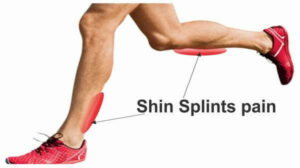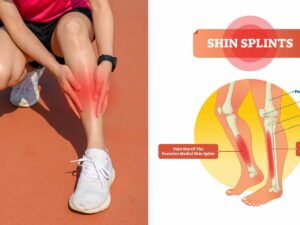Have you ever experienced shin splints? If so, you are not by yourself. Shin splints are a frequent injury that can be very difficult to manage. They can prevent you from engaging in your favorite activities and significantly impede your daily life. This article will explain what shin splints are, and how to permanently eliminate them.
Contents
What Is Shin Splints?
 Injuries to the muscles, tendons, and bones that make up your shins are known as shin splits or shin splints. They may develop due to overusing these muscles during sprinting or jumping. Shin splints can cause discomfort, swelling, and a reduction in the range of motion in your legs. If left untreated, shin splints can lead to more serious conditions like stress fractures.
Injuries to the muscles, tendons, and bones that make up your shins are known as shin splits or shin splints. They may develop due to overusing these muscles during sprinting or jumping. Shin splints can cause discomfort, swelling, and a reduction in the range of motion in your legs. If left untreated, shin splints can lead to more serious conditions like stress fractures.
Moreover, the overuse of the muscles in your lower legs, incorrect technique, and weak ankles and knees can also cause shin splints. In an effort to maintain balance, people frequently either roll their feet toward the outside or their ankles in, which causes tension on the leg muscles and is another reason for shin splints or wearing inappropriate footwear.
Effective Treatment For Shin Splints
Fortunately, shin splints are frequently curable. Here are some easy steps you may take to avoid shin split worsening.
Stretching regularly
This can help improve flexibility in your lower legs, reducing the risk and severity of shin splints. Regular stretching can also help to prevent injuries by loosening tight muscles, improving posture, and strengthening the core muscle. Some of the stretches which you can do to strengthen your shin are, calf raises, straight-leg raises, seated shin raises, hamstring stretches, tight toe flexors, etc.
Wearing proper footwear
Choosing shoes that provide adequate arch support and shock absorption can help to reduce strain on your lower legs. Opt for running shoes or other athletic footwear that are designed specifically for the activities you do most often. To be sure you’re wearing the proper running shoes, seek assistance from a specialist at a running specialty shop. To assist you to find the right fit, running professionals can look at your motion, the makeup of your feet, and the level of wear on your present running shoes.
Taking rest days
Taking at least one or two days off from running each week, regardless of how experienced you are, lowers your risk of developing shin splints and other overuse issues. This gives your muscles time to recover and reduces the risk of injury.
Foam rolling
Regularly rolling out your lower legs with a foam roller can assist to loosen up your muscles there, increasing flexibility and circulation. You may buy a foam roller at most sporting goods stores, order one online, or utilize one at your neighborhood gym.
Quitting smoking
If you smoke, quitting can also help to reduce your risk of developing shin splints. Smoking decreases blood flow to the lower legs and may contribute to inflammation, making it harder for muscles and tendons to recover from injury. In addition to preventing shin splints, quitting smoking can improve your general health and reduce your risk of other overuse injuries.
Ice packs
This type of treatment for shin splints involves applying ice packs to the affected area for 20 minutes at a time. Applying ice to your lower legs can help reduce inflammation, alleviate pain and discomfort, and promote healing. For example, you can wrap an ice pack in a towel and hold it to the outside of your shin.
Seeking professional treatment
 Talk to your doctor or a physical therapist about establishing a personalized strategy for avoiding and treating shin splints if you have excruciating pain, swelling, or other symptoms that interfere with your everyday activities. They might suggest particular stretches, exercises, or therapies like massage, ice, or ultrasound. They might also suggest orthotics or other supporting devices keep you active without running the risk of getting hurt.
Talk to your doctor or a physical therapist about establishing a personalized strategy for avoiding and treating shin splints if you have excruciating pain, swelling, or other symptoms that interfere with your everyday activities. They might suggest particular stretches, exercises, or therapies like massage, ice, or ultrasound. They might also suggest orthotics or other supporting devices keep you active without running the risk of getting hurt.
Take Painkillers
The best course of action is to take painkillers if you need relief right now. Anti-inflammatory medications like aspirin and ibuprofen will ease your pain and inflammation. However, these medications can have undesirable side effects. Unless your doctor advises differently, take them as instructed on the label.
In this way, there are many effective methods for preventing and managing shin splints. Whether you choose to focus on increasing flexibility, purchasing proper footwear, taking rest days, foam rolling up regularly, quitting smoking, or seeking professional treatment, there are plenty of ways to reduce your risk or help heal this condition.
By incorporating some of these strategies into your daily routine, you can enjoy a lifetime of active living free from this condition and other overuse injuries.
Conclusion
Even though shin splints can be a painful and irritating ailment, you can easily prevent and treat it with the correct workouts and focused interventions. You can help prevent and treat these conditions before they worsen by including some or all of these treatments mentioned above, into your normal regimen.
Moreover, if you are struggling to find the right treatment then contact Mantra Care for assistance. With years of experience in the field, we can help you connect with the right professional for your needs. You can also book an online therapy or download our free Android or iOS app.


